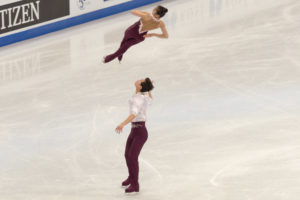Kim Jong-un turned thirty-four on January 8, 2018, but the international community waited until February to present him with the best birthday present that he could ask for: the 2018 Winter Olympics held in Pyeongchang, South Korea. For two weeks in February, the world’s finest diplomats and its greatest collection of athletes resided just fifty miles from the Korean Demilitarized Zone. Billions of people around the globe tuned in to watch the Games, making North and South Korea the axes of the Earth for its duration. Kim exploited this brief moment of integration with the international community as a way of bolstering his quest to humanize and legitimize the North Korean regime in previously unthinkable ways.
In the months preceding the Winter Games, Kim Jong-un gained unprecedented leverage over his international foes. With his rapidly advancing nuclear arsenal now thought capable of striking the entire continental United States, Kim can afford to stand firmly behind his regime’s aggression. An emboldened North Korea refuses to be deterred by international pressure, and, as Foreign Policy Magazine reports, the “contest to contain North Korea has developed into an international game of whack-a-mole, with Pyongyang popping up with new money-making ventures for every enterprise shut down as a result of U.S. and U.N. sanctions.”
With just under 200 miles separating Pyongyang from Pyeongchang, Kim Jong-un was fully capable of initiating an attack on the Winter Games. The North Korean dictator has also threatened the United States, declaring that the “Nuclear Button is on his desk at all times,” and referred to President Trump as a “mentally deranged US dotard.” Kim’s unpredictable behavior and belligerent rhetoric, especially concerning President Trump, lended credibility to such an attack. Growing tension between these two leaders stokes worries of a hot war breaking out between their two countries.
In this atmosphere of great uncertainty, Kim Jong-un found himself in a position of strength during negotiations with South Korean President Moon Jae-in over concessions for the Games; President Moon had little choice but to acquiesce to the North’s demands. During the opening ceremony, the North and South marched together under the blue unification flag, repeating this symbolic gesture from the 2000, 2004, and 2006 Olympic Games. In an unprecedented move, the two countries competed as one Korean women’s hockey team.
Despite these visible signs of North Korean presence at the Games, Kim Jong-un’s more subtle maneuvers were of far greater importance to the regime. In particular, Kim used prominent female figures to soften the appearance of and increase the likeability of the regime. During the opening ceremony, his high-ranking sister, Kim Yo-jong, sat behind Vice President Pence. This strategic placement not only legitimized Yo-jong, but associates a much friendlier face with the regime than that of her brother.
Kim turned his attention away from direct political promotion and has instead focused on bringing North Korea’s social and artistic talent to life. Hyon Song-wol, the leader of the popular, all-female Moranbong Band (and suspected ex-love interest of Kim Jong-un) appeared at the Games earlier in the week. Like any pop-star, Hyon received the full attention of the Korean media and dominated local headlines. Immensely talented and beautiful, Kim hoped her presence would tacitly push the international community to look upon North Korea with sympathetic eyes. Moreover, Kim continued to flaunt the North’s supposed wealth of artistic talent by sending the 137-strong Samjiyon Band to serenade the Olympic crowds.
Perhaps the most intriguing attempt by Pyongyang to appeal to Western culture was the North Korean pair figure skating team’s song choice for their short program performance: a cover of “A Day in the Life” by the Beatles. The Beatles represent a spirit of vigor, innovation, and love and are instrumental to the identity of generations of adults across the United States and Europe. By choosing to skate to “A Day in the Life,” the North Koreans immediately endeared themselves to millions of people watching the competition and presented a previously unprecedented degree of openness vis-à-vis Western culture and music. It became far easier to cheer for North Korea after observing these sympathetic personas as representatives for the country.

This barrage of creative talent defies our perception of North Korea; Kim Jong-un wants the global community to question its assumptions of the brutality of his regime. After all, Kim forces the world to ask itself, can an oppressive regime truly foster a collection of artists, musicians, and athletes such as the ones that the North has presented? While the answer is of course ‘yes,’ sending these individuals to Pyeongchang for the Games was a careful, yet brilliant, political calculation by Pyongyang to showcase a degree of humanity that has rarely been displayed by the notorious regime. To the casual observer, North Korea seems like a far more welcoming and friendly place than one might have assumed prior to watching coverage of the Olympics. Nevertheless, the international community must continue to pressure the North Korean regime away from its persistent nuclear development and brutal internal controls. Sanctions through the United Nations will be critical to this effort, as will the partnerships among the United States, China, and South Korea. It might take an Olympic-sized effort to accomplish this, but, if North Korea can do it, so can the rest of the world.
